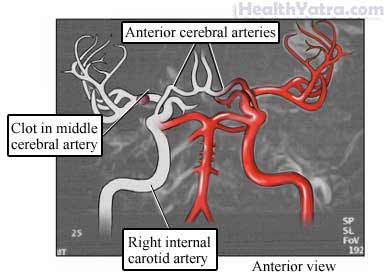Definition
MRA is a study of the blood vessels using magnetic resonance imaging (MRI). Using a large magnet, radio waves, and a computer, an MRA makes two-dimensional and three-dimensional pictures.

Reasons for Test
This test is done in order to:
- Identify diseased, narrowed, enlarged, and blocked blood vessels
- Locate internal bleeding
Possible Complications
MRIs can be harmful if you have metal inside your body such as joint replacements or a pacemaker. Make sure your doctor knows of any internal metal before the test. Some people may also have an allergic reaction to the contrast dye. Talk to your doctor about any allergies you have. Also, let your doctor know if you have liver or kidney problems. These may make it difficult for your body to get rid of the contrast.
What to Expect
Prior to Test
Before the test, your doctor may:
- Ask about your medical history
- Perform a physical exam
- Do blood tests
If your doctor prescribes a sedative:
- Arrange for a ride home.
- Do not eat or drink for at least four hours before the exam.
- Take the sedative 1-2 hours before the exam, or as directed.
At the MRI center, you will be asked if you have something in your body that would interfere with the MRA, such as:
- Pacemaker or implantable defibrillator
- Neurostimulator
- Ear implant
- Metal fragments in your eyes or in any other part of your body
- Implanted port device, such as an insulin pump
- Metal plate, pins, screws, or surgical staples
- Metal clips from aneurysm repair
- Retained bullets
- Any other large metal objects in your body
You may be:
- Given earplugs or headphones to wear. The MRI machine makes a loud banging noise.
- Given an injection of a contrast dye into your vein.
- Allowed to have a family member or friend with you during the test.
Description of the Test
If contrast is used, a small IV needle will be inserted into your hand or arm before you are moved into the MRI machine. The contrast will be injected during one set of images. It helps to make some organs and vessels easier to see on the pictures. You might have an allergic reaction to the dye, but this is rare
You will lie on a special table. This table will be moved inside the opening of the MRI machine. Most MRIs consist of 2-6 sets of images. Each one will take between 2-15 minutes. You will need to lie still while the images are being taken. You may need to hold your breath briefly. Technicians will communicate with you through an intercom from another room.
After Test
- You will be asked to wait at the facility while the images are examined. The technician may need more images.
- If you took a sedative, do not drive or operate machinery until it wears off.
- If you are breastfeeding and receive contrast dye, you and your doctor should discuss when you should restart breastfeeding. Information available has not found any ill effects to the baby if a breastfeeding mother has had contrast dye.
- Be sure to follow your doctor’s instructions.
How Long Will It Take?
40-90 minutes
Will It Hurt?
The test is painless. If contrast is used, you may experience a stinging sensation when the IV is inserted.
Results
Your doctor will discuss the findings with you and any treatment you may need.
Call Your Doctor
Call your doctor if any of the following occur:
- New or worsening symptoms
- Allergic or abnormal symptoms if contrast material was used
If you think you have an emergency, call for medical help right away.
